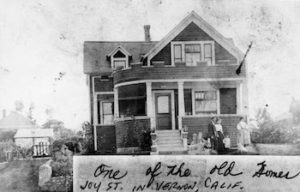
Joy Street House, Vernon, CA
*The Furlong Tract Community is celebrated on this date in 1905. This was one of the first Black neighborhoods in Los Angeles, CA. Located in Vernon, CA, part of greater L.A., Furlong Track was created when James Furlong subdivided his land, bounded by Long Beach Avenue and Alameda, 50th and 55th streets, and sold lots to Blacks.
A 1995 Los Angeles Times article recalled: "He sold his lots to black families for the going price of $750. From the start, the Furlong Tract was a working-class area, settled by people … who were barred from other areas by restrictive racial covenants or high prices." The Furlong Tract was a working-class area settled by people like the Guillebeaus, Postells, and Hickses, who were barred from other areas by restrictive racial covenants or high prices. The area had convenient transportation (the Main Streetcar lines ran through the center of the neighborhood).
Many families worked for what was then the generous sum of $3.75 a day at such nearby plants as the Cottonseed Oil Mill, the Hercules Foundry, and Pioneer Paper Co. Some families lived in tents while they built their modest homes. Eventually, the tract had more than 200 houses, grocery stores, a pharmacy, doctors’ offices, a florist, dry cleaners, an ice cream parlor, a real estate office, an icehouse, a community hall, three churches, and a school.
Built in 1910, the one-story, wood-frame 51st Street School became the first all-Black school in Los Angeles. It changed its name to Holmes Avenue Elementary but only hired white teachers because discriminatory hiring kept Black teachers out of many cities in the state, including Los Angeles. That changed when Bessie Burke was hired in 1918. The Furlong Tract became one of the first large Black communities in Los Angeles.